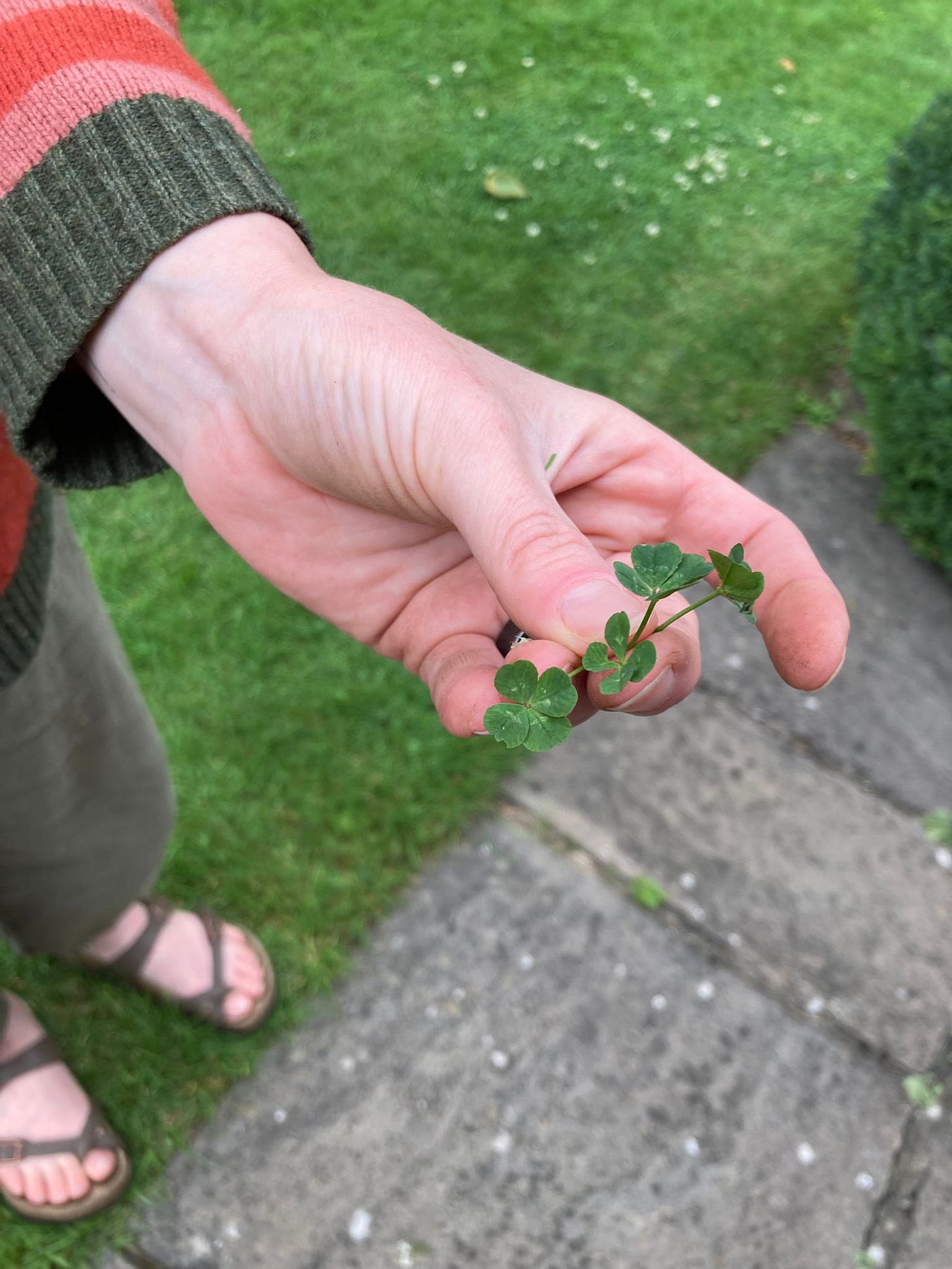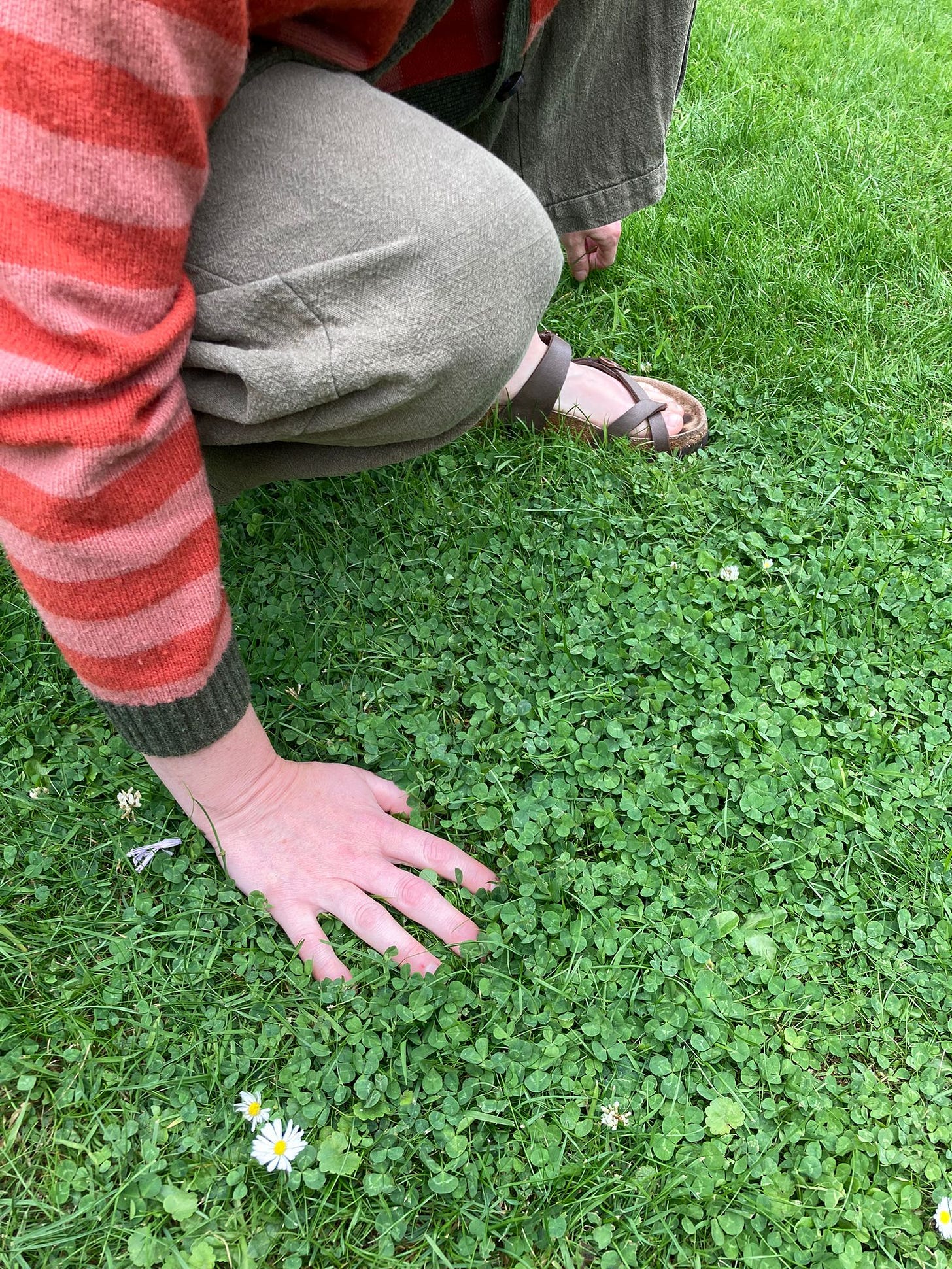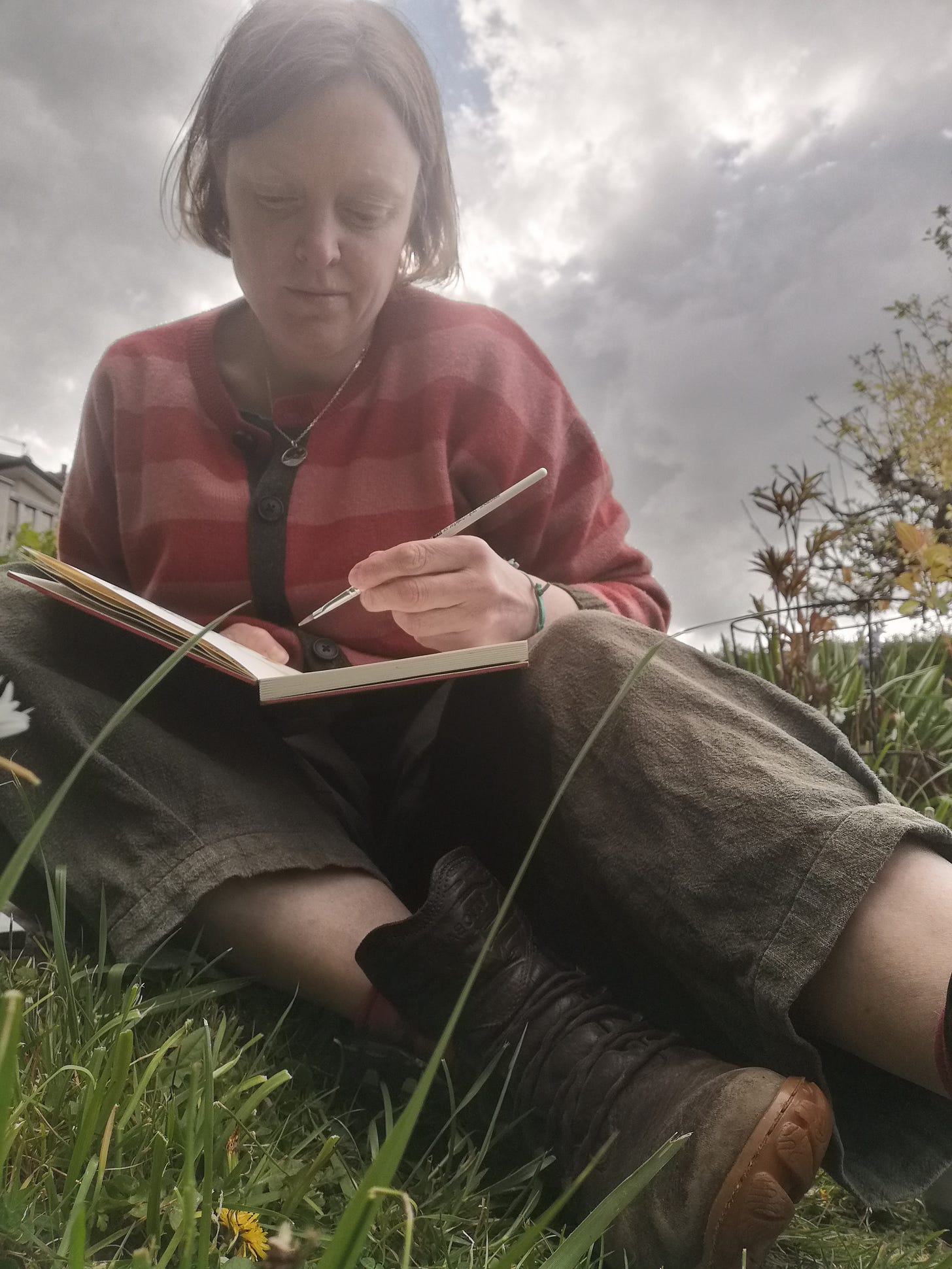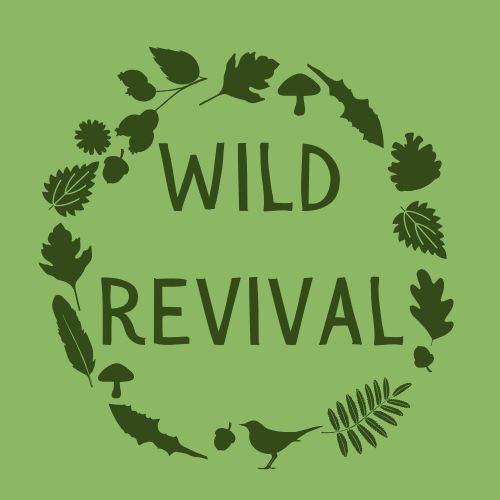Welcome to Wild Notes, my monthly letter to everyone following Wild Revival. I’m Jo, a forager and creative who finds both relief and inspiration in Nature, and this publication is where I share my seasonal noticings and plant wisdom with you. Think of it as a gentle prompt to get outside and interact with Nature in a way that feels nourishing to you. I’m so glad you’re here!
Hello Wild Ones,
August is settling in, with changeable weather and temperatures that make me unsure what to do or wear each day! I’m away from Northumberland just now visiting Lincolnshire and we’ve had hot sunny days, rain and storms, chilly mornings, warm winds, the lot; but I have been making sure to get outside in my parents’ garden each day. This morning a little stroll with a coat on through the raindrops, but other days I’ve spent catching the sun, reading or painting, watching the nesting Goldfinches or helping to water and weed.
A few days ago, after doing some yoga on the lawn, my attention was caught by the Clover patches and my inner child spoke to me: ‘I’m going to find a four-leaved clover’. Unlike when I was a child, my adult self was not attached to this outcome of finding the treasure - I just thought it would be fun and interesting to look. I certainly spent hours as a young girl looking for these elusive leaves, not always finding them but I know I found a handful over the years. And I found several the other day!
White Clover - Trifolium repens
The Clover that we tend to find growing in our lawns is White Clover, a perennial plant that grows each Spring. It has creamy white flowers, sometimes tinged pink at the base of each flower, that form little tuft-like flowerheads. The bees absolutely adore Clover and can often be seen visiting each flower on a lawn. The leaves, as the Latin name suggests, grow in 3 parts (tri = 3 and folio = leaf). The second part names it a low-growing plant that spreads, as repens means ‘creeping’. The leaves often have a pale ‘V’ shape on them, and each of the 3 leaflets is a lovely heart-shape with a distinct crease down the centre - like lovely green origami.
Other Clovers you might notice are Black Medick, which has clover-shaped leaves but smaller and yellow flowers, Red Clover which is a taller-growing annual clover with pink flowers, or Crimson Clover which is also tall and with brighter red elongated flowers. This last one is not native to the UK but you may find it naturalised near fields where farmers have sown wildflower mixes; the Red and Crimson clovers can grow happily at field edges and aren’t usually found in cropped grass. Another Clover-Chamaeleon (a lookalike to fool you) is Wood Sorrel, not a clover at all but an Oxalis with the same distinct leaf shape. Wood Sorrel grows in woodland and has pretty pale pink flowers, or you might notice Creeping Woodsorrel with yellow flowers.
Lucky Leaves
Four-leaf Clovers are well-known lucky charms, the idea thought to originate in Celtic symbolism, but the image and association could well be much older. Clover plants sometimes produce these 4-lobed leaves as a genetic anomaly - they can be on any Clover plant, and I have found several on one plant on many occasions, but not every plant will have one! The luckiness of finding one is generally accepted because of their rarity - a search online suggests that they are as rare as 1 in 5,000 but I don’t suppose there have been a lot of scientific studies on it!
I know that when I slow down enough, when my nervous system is regulated, when I’m not pulled in many different directions and I create for myself time to sit on the grass, that I feel lucky.
Looking for Treasure
I found last week that the brightest benefits of looking for 4-leaf clovers were unintended and spontaneous. The connection that I felt to myself, my body, and Nature whilst in this practice of play, was significant. I would love to encourage you to go outside and find a bit of grass that you can try this out on - your garden, a park, a recreation ground, a golf course - and I’ll give you my suggestions for making the most out of it. Choose one or do the list!
1. Noticing Plant Species
Whilst I was getting close to the ground, I could see that the lawn was made up of many more species of plants than I’d first thought. I named the ones I recognised as I came across them - Black Medic, Self-heal, Daisy - you might also find Dandelion, Greater Plantain, Speedwell, Buttercup. Let me know if you spotted anything else! If you don’t know a lot of wild plant names, don’t skip this, but really notice what you are seeing. Give it your own name or describe what you see - ‘I can see that purple flower again’ or ‘there’s a bunch of round leaves in the grass here’. Get intimate with a square metre of lawn, because life is too fast not to. Beyond plant species, you might notice the animals, the bumblebees looking for nectar, ladybirds, worms if it’s rained recently, or hear the birds singing while you are still and quiet.
2. Grounding
Take your shoes off. Even if you’re at the park. Especially if you are on the golf course. Definitely if it is wet!
Grounding through the soles of our feet in contact with the soil or grass is a wonderfully supportive practice. Touching our skin to soil releases serotonin in the brain and the wild yeasts, microbes, energies make our bodies respond with calm, joy and positive feelings. I feel a sense of belonging when I’m barefoot outside, and it gets me into a more carefree, playful state of mind, which of course triggers the parasympathetic response of our nervous systems, ‘Rest and Digest’ mode which does what it says on the tin.
3. Animal Movement
I have a daily yoga practice, and as I said earlier this leaf hunt was inspired by my yoga on the lawn, but when I say ‘animal movement’ I mean something a little different to most yoga asana routines. A type of somatic movement, sometimes referred to as Animal Flow or Quadrupedal Movement Training, a kind of ergonomic mobility exercise that sounds really strange but is actually incredibly intuitive and natural. Moving around on all fours like an animal (or various animals) encourages our bodies to move in non-habitual ways, stretching muscles usually unused, interacting with our balance and body-weight shifting, and seeing perspectives of our surroundings that are usually unavailable to us. All of these things promote healthy brain as well as muscle function, limbers joints and gets us in a state of really listening to our own bodies. The feedback from the grass and the ground on your hands and feet, the nuance of moving your spine vertebrae by vertebrae, of shifting your weight from feet to hands and back again. Try crouching in a squat as you look for Clover leaves, try folding forward and looking upside down, try placing your forearms on the ground and straightening one leg out at a time. All of these movements are slow, mindful and self-initiated; don’t go past your own limits, push yourself too far or try to reach a certain ‘pose’, just think of a shape or movement you don’t habitually make and try it.
I usually groan in yoga when I’m asked to do a yogic squat, but while I was looking at Clover patches intently, I felt my hips stiffen and moved into a low squat to relieve them. This morphed into crawling about the grass with my hands on the floor and my knees bent up like a frog sitting! It did wonders for my hips and my lower back.
4. Capacity for Play
My last prompt is to stretch what you think your capacity is, either for ‘doing nothing’, for playing, or being ‘silly’ or unproductive. Which thought came to your mind as you read this post? What reason do you give automatically for not spending time in Nature, sitting on the lawn or gazing at the sky?
Notice your answer, but whichever reason comes up for you, whatever flavour of resistance, try setting a timer. You decide the time based on how strongly your stories of productivity run in your mind! 5 minutes, 10 minutes, 30 minutes…however long you think you could spend looking for a 4-leaved clover, set the timer a little longer. Stretch yourself to look a little longer. I really feel that things like creativity, play, meditation, spirituality, connection, rest…they are muscles that we need to use and flex, to grow our capacity for, for our own wellbeing. And future-us will thank us for it!
I’d love to hear if you’re going to try these! Share your experience or your 4-leaf clover stories with the Wild Revival community below.
Support my next (barefoot) steps…
This September, I’ve been offered a place on a unique artist residency on Dartmoor called Lessons in Listening. It’s a rare chance for me to step away from the everyday and immerse myself in my creative practice amongst other artists. I’ll be learning land-based skills, regenerative practices and tuning into the landscape to return with fresh inspiration, and a renewed sense of purpose. I’m currently crowdfunding £1130 to make it happen — and if you’ve ever found value in my work, I’d be so grateful for your support. Every contribution helps: click here to donate 🌿
…and message me to let me know you’ve donated, as every donor is entered into a giveaway to say thank you for all the incredible support for my residency crowdfunder! I’m giving away a handmade woven ivy basket I created from foraged materials to one lucky winner! Plus, I’m gifting a few mini colour palette cards, hand-painted with my own natural inks, to randomly selected supporters. Sharing the love!
If you’d like to read more Wild Notes, visit my archive of free posts here!
See you outside,
Jo xxx












